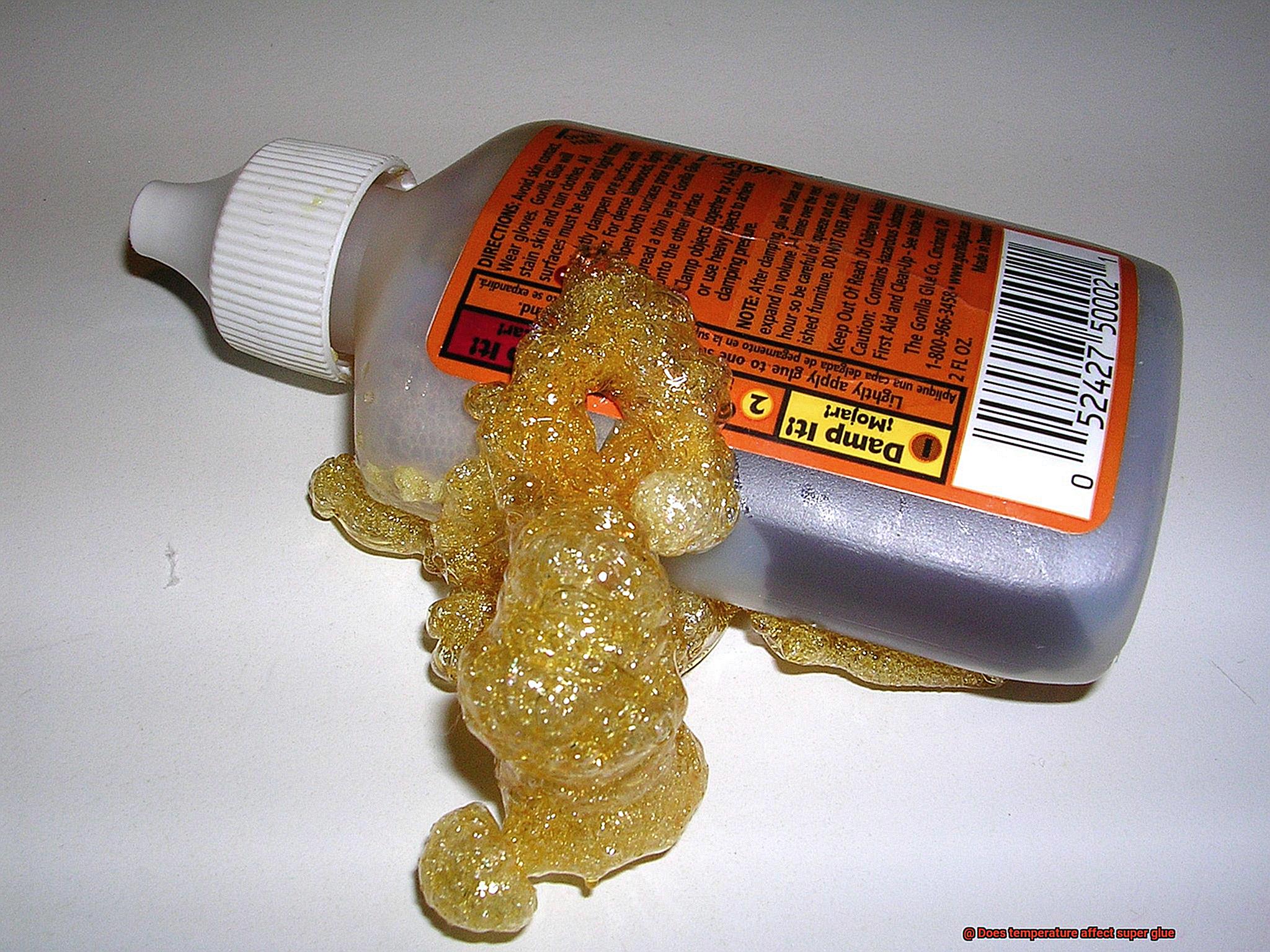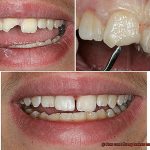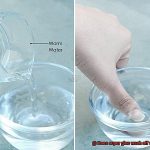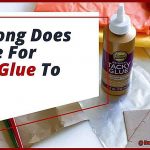The hero of all DIY mishaps and crafty creations. This magical adhesive has saved us from countless broken objects and held our projects together with its mighty bond. But have you ever wondered how temperature can throw a wrench in its superpowers?
Temperature is like the secret villain that messes with super glue’s performance, messing up its ability to form strong bonds. To unravel this mystery, let’s dive into the captivating chemistry behind this sticky substance.
At its core, super glue (or cyanoacrylate adhesive for the fancy folks) is a complex polymer that cures faster than a speeding bullet when it meets moisture. When you apply it, it undergoes a crazy reaction called polymerization, transforming from a liquid to a solid state while releasing heat energy. Talk about some hot chemistry.
Now, let’s get down to business and see how temperature affects this transformation and messes with the strength of super glue’s bond.
Cold Temperatures:
Contents
- 1 Effects of Temperature on Super Glue
- 2 Ideal Temperature Range for Using Super Glue
- 3 Lower Temperatures and Super Glue
- 4 Higher Temperatures and Super Glue
- 5 Heating Sources to Avoid with Super Glue
- 6 Storing Super Glue in the Right Conditions
- 7 Tips for Getting the Most Out of Your Super Glue
- 8 Conclusion
When things get chilly, super glue turns into an Olympic sloth in the curing process. Lower temperatures slow down the rate of polymerization, making it take forever for the adhesive to harden. And we all know that patience isn’t our strongest suit.
In freezing conditions, super glue might not even cure completely because cold environments tend to suck out moisture faster than your sibling devours cookies. And guess what? Water is like the sidekick that helps with the curing process.
Hot Temperatures:
On the flip side, when things heat up, so does super glue’s need for speed. High temperatures can make it cure faster than you can say “super-duper.” But hold your horses – rapid transformations come at a cost.
Too much heat can cause super glue to harden before it gets a chance to form an ironclad bond. It’s like trying to stick two pieces together before the glue is ready to do its thing. And let’s not forget that intense heat can also evaporate moisture, leaving super glue high and dry.
Room Temperature:
Super glue likes it just right, like Goldilocks searching for the perfect porridge. Working at room temperature (around 20-25°C or 68-77°F) gives super glue its best shot at success.
At this temperature, super glue shows off its finest curing skills, finding the perfect balance between
Effects of Temperature on Super Glue
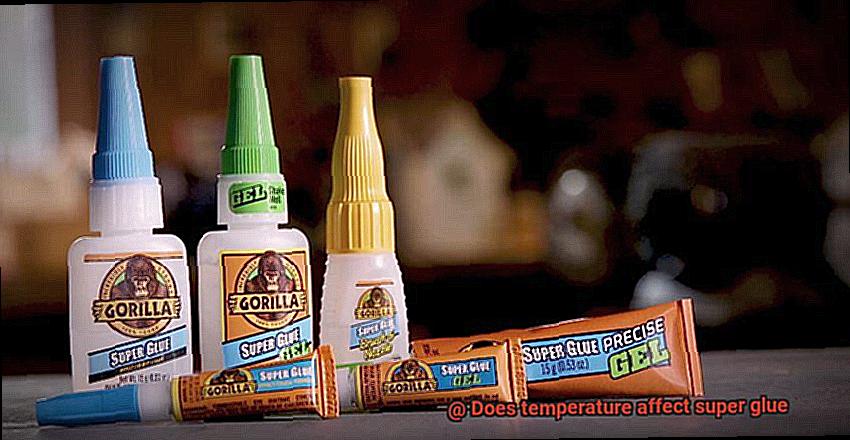
Super glue, a remarkable adhesive that finds its place in countless applications, holds a secret hidden in plain sight – temperature can make or break its bond. In this captivating exploration, we will delve into the captivating world of super glue and unravel the enigmatic interplay between temperature and its performance.
The Optimal Temperature Range:
Like a master conductor guiding an orchestra, temperature plays a pivotal role in super glue’s symphony of bonding. Manufacturers recommend a sweet spot between 50°F (10°C) and 77°F (25°C) for achieving optimal results. Within this magical range, super glue cures gracefully, forming an unyielding bond. Venture beyond these boundaries, and the harmony starts to falter.
The Arctic Chill:
Enter the realm of frigid temperatures, where super glue’s power diminishes. The biting cold slows down the evaporation of moisture, delaying the curing process and weakening the bond. In extreme cold conditions, it is best to keep super glue warm and snug, as it shivers in the face of low temperatures.
The Fiery Inferno:
Now let us journey to a land scorched by heat, where super glue’s resilience is tested. Under scorching temperatures, this adhesive maestro becomes more fluid, eluding control during application. Rapid curing ensues, potentially compromising the strength of the bond. Beware, for exposing super glue to direct sunlight or searing surfaces can ignite a symphony of weakened bonds.
The Sanctum of Storage:
The art of preservation lies at the heart of maintaining super glue’s effectiveness. Seek refuge in cool and dry sanctuaries, away from the glaring gaze of sunlight and tumultuous temperature shifts. Such precautions ensure longevity and prevent the degradation of this adhesive virtuoso.
The Trailblazers: Specialized Formulations:
In the realm of extremes, where ordinary super glue falters, a new breed emerges. Visionary manufacturers have crafted specialized formulations to withstand the harshest environments. These heroic super glues defy temperature’s whims and offer unwavering performance, ensuring steadfast bonds even in the face of adversity.
Ideal Temperature Range for Using Super Glue
Super glue, that trusty adhesive that holds our world together, has a secret: it’s a bit picky when it comes to temperature. Just like Goldilocks and her porridge, super glue prefers things to be just right. So, what is the ideal temperature range for this sticky wonder? Well, grab a cup of coffee and let’s dive in.
The sweet spot for super glue is typically between 50°F and 77°F (10°C to 25°C for our metric friends). In this cozy range, the glue works its magic, forming unbreakable bonds that would make even the Hulk jealous. But venture beyond these boundaries, and things start to get complicated.
In colder temperatures, super glue becomes sluggish. The curing process slows down, and it may take longer for your materials to bond properly. To combat this frosty dilemma, try warming up the surfaces or materials before applying the glue. A little heat can go a long way in ensuring a strong bond.
On the flip side, when temperatures rise above the ideal range, super glue can turn into an overachiever. It cures too quickly and can become brittle, leading to weakened bonds. If you find yourself in a scorching environment, consider using a quicker-setting variant of super glue designed specifically for high-temperature applications.
But temperature isn’t the only factor at play here. Humidity and surface cleanliness also influence how well super glue performs. So, keep things clean and dry for optimal results.
To summarize:
- Ideal temperature range: 50°F to 77°F (10°C to 25°C)
- Colder temperatures: Slow curing process, warm up surfaces or materials before applying
- Hotter temperatures: Quick curing process, consider using high-temperature variant
- Check manufacturer’s instructions for specific guidance on temperature requirements
- Maintain clean and dry surfaces for best results
Lower Temperatures and Super Glue
Today, we embark on an exhilarating journey into the captivating realm of super glue and its intricate relationship with lower temperatures. While we are all aware of the remarkable bonding capabilities of super glue, it is time to unveil the hidden secrets of how temperature influences its performance. Prepare yourself for a thrilling exploration.
Decoding the Science:
Lower temperatures wield their influence over super glue, causing it to adopt a leisurely pace when it comes to setting and curing. This is due to the fact that the chemical reaction upon which super glue relies requires moisture in the air to initiate the curing process. With diminished moisture levels at lower temperatures, the curing process decelerates, leading to prolonged bonding times.
The Viscosity Dilemma:
Imagine this scenario: the icy chill of winter surrounds you as you attempt to apply super glue. Alas, a complication arises. The adhesive transforms into a denser and more viscous state, making it arduous to spread evenly. Though vexing, fret not. We have a few tricks up our sleeves.
Expert Tips for Triumph:
- Warm it Up: Combatting the challenges posed by lower temperatures entails preheating your materials or surfaces prior to applying super glue. A heat gun or cozying up near a heater will work wonders.
- Heat Therapy: Remember to pamper your super glue too. Indulge it with a warm bath by submerging the bottle in a bowl of tepid water for a few minutes. Exercise caution not to overdo it, as excessive heat can compromise its efficacy.
- Accelerate Your Way: Contemplate utilizing accelerators tailored specifically for cyanoacrylate adhesives. These enchanting concoctions contain chemicals that expedite bonding even amidst frigid conditions.
Adherence to the Rules:
As is the case with any adhesive, adhering to the manufacturer’s instructions when using super glue, accelerators, or activators is of paramount importance. Remember, improper application can lead to feeble bonds and disillusionment.
Conclusion:
Congratulations. You have achieved expertise in the realm of super glue and temperature dynamics. While lower temperatures may cast a frosty shadow on your bonding endeavors, armed with the knowledge we have imparted today, you possess the ability to conquer any chilling challenge that comes your way. So, my glue-loving comrades, venture forth and let your bonds remain unyielding, even within the most bone-chilling environments.
Higher Temperatures and Super Glue
In this article, we will delve into the fascinating world of glue chemistry to uncover the secrets behind how higher temperatures affect the performance of this versatile adhesive.
Fast and Furious Bonding:
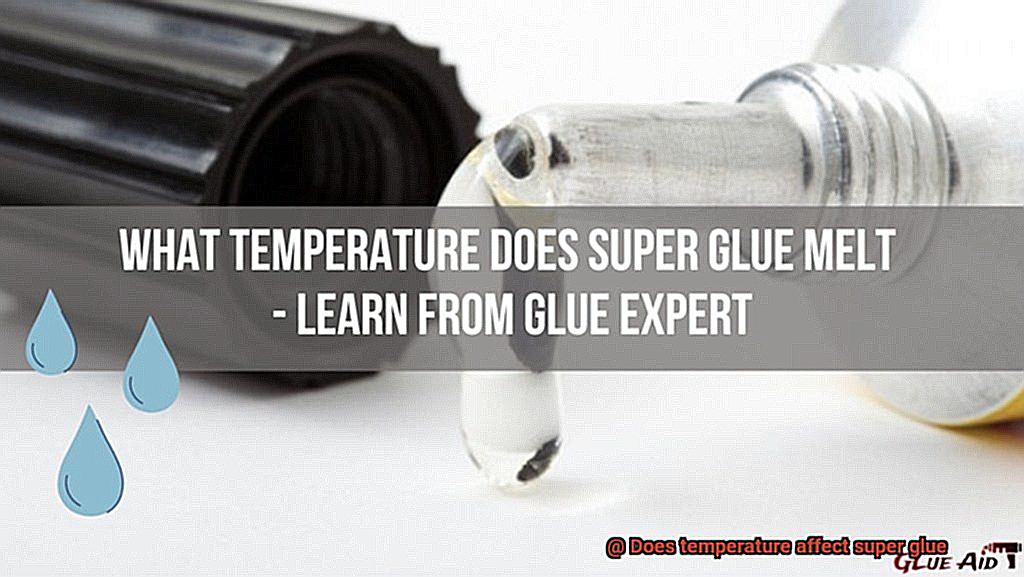
When the mercury rises, so does super glue’s curing process. Higher temperatures accelerate bond formation between surfaces, allowing for quicker project completion. Working in warmer conditions means your projects can be completed in record time.

The Viscosity Conundrum:
However, there’s a flip side to the heat. Higher temperatures cause super glue to thin out, reducing its viscosity or consistency. This can make precise application tricky, requiring caution to avoid messy mishaps.
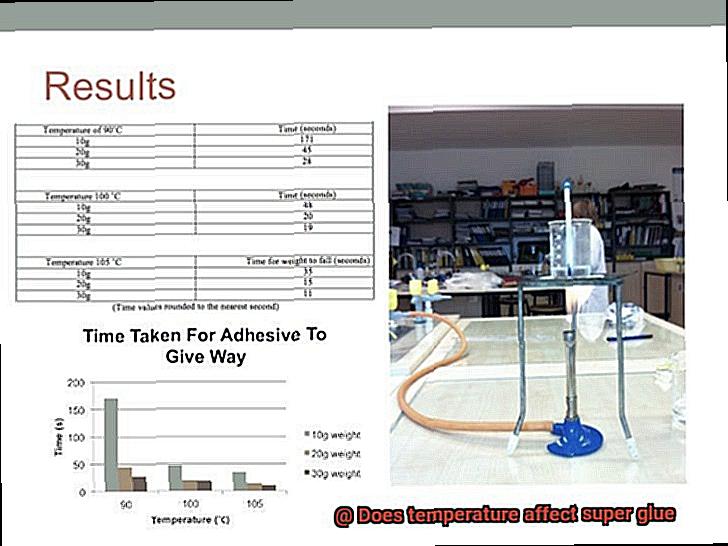
The Breaking Point:
Excessive heat can also compromise the strength and durability of super glue. Staying within the recommended operating temperature range is crucial for optimal bonding performance. Pushing beyond these limits may result in weakened bonds that compromise your projects’ integrity.
Cold Feet and Slow Curing:
On the other end of the temperature spectrum, extremely low temperatures slow down super glue’s curing process. Cold conditions make the adhesive thicker and more viscous, challenging its flow and effectiveness in bonding. Freezing temperatures can render super glue brittle and ineffective.
Specialized Solutions:
Different types of super glue exist for specific temperature ranges. If you anticipate working in high-temperature environments or extreme cold conditions, consider using specialized formulations designed to withstand these challenges.
Tips and Tricks:
To achieve optimal results at higher temperatures, follow the manufacturer’s instructions regarding temperature ranges and application techniques. For faster curing, accelerators or activators developed for use with super glue can speed up the bonding process while maintaining strength and reliability.
Heating Sources to Avoid with Super Glue
When it comes to using super glue, it’s important to be mindful of the heating sources you expose it to. To ensure a strong and reliable bond, avoid the following sources of heat:
- Flames, hot surfaces, and open fires: Direct exposure to flames or hot surfaces can cause super glue to melt or degrade. So, resist the temptation to use your stove or oven as a drying station for your glued pieces. Instead, find a cool and dry place to let them cure naturally.
- Hairdryers and heat guns: While these devices may blow hot air, they can blow away the effectiveness of your super glue. The rapid increase in temperature can weaken the bond and leave you with a disappointing result. Save the hairdryers for your luscious locks and let your glued creations dry at room temperature.
- Rushing the curing process: Patience is key when working with super glue. Allow enough time for the glue to fully cure and set before subjecting it to any high temperatures. Rushing the process may result in a weak bond that won’t stand the test of time.
Remember, if your super glue has been exposed to excessive heat and has become melted or compromised, it’s best to start afresh with a new batch. Starting with fresh glue will give you the best chance of success in your crafting endeavors.
Storing Super Glue in the Right Conditions
Today, we embark on a sticky adventure into the intriguing world of super glue. Join us as we explore why storing this magical adhesive in the right conditions is vital for maintaining its quality and performance. So grab your favorite adhesive and let’s dive in.
The Temperature Predicament:
Ah, temperature, a double-edged sword in the realm of super glue storage. Imagine subjecting your adhesive companion to scorching heat that melts it faster than a summer popsicle. Weakened bonds and reduced effectiveness? Not what we’re aiming for.

On the flip side, storing super glue in freezing conditions turns it into a stubborn beast, thicker than a frozen popsicle. Applying it becomes as challenging as sculpting ice in a volcano. Trust me; you don’t want that headache.
The Ideal Habitat:
To keep your super glue happy and effective, it needs a cozy home at room temperature – the Goldilocks range between 68°F to 77°F (20°C to 25°C). Find a cool, dry place away from sunlight and heat sources, where your little bottle can rest undisturbed.
Seal It Up:
Sealing secrets in an envelope is like keeping your super glue container tightly sealed when not in use. Air sneaking in can cause premature curing – imagine opening an envelope to find a vanished message. We don’t want that with our adhesive, do we?
Moisture: The Unwanted Guest:
Moisture is the uninvited guest that ruins the party. Keep your super glue away from humid environments. Moisture triggers premature curing or reduces effectiveness faster than a spilled drink ruins your crafting project. Let’s keep the moisture at bay for adhesive longevity.
The Fridge Conundrum:
Ah, the refrigerator, a cool oasis for many things. But before you throw your super glue into its chilly embrace, pause for a moment. While some brands suggest refrigeration to extend shelf life, check the manufacturer’s instructions. Not all super glue types are meant for chilling out in the fridge.
Tips for Getting the Most Out of Your Super Glue
When it comes to using super glue, temperature plays a crucial role in its performance. To achieve optimal results, it’s best to use super glue at room temperature, typically between 68°F to 77°F (20°C to 25°C). Extreme temperatures can have a significant impact on the glue’s effectiveness. In cold temperatures, the glue may take longer to set and bond.
To counter this, warm up the surfaces you’re bonding by using a hairdryer or placing them in a warm area for a few minutes before applying the glue. On the flip side, in hot temperatures, super glue can dry too quickly or become less effective.
If you find yourself working in a scorching environment, cool down the surfaces before applying the glue.
Surface Preparation:
Before diving into the magical world of super glue bonding, make sure to prepare your surfaces properly. Thoroughly clean and dry the surfaces you’re bonding, leaving no room for moisture or contaminants that could interfere with the bond. Grab a clean cloth and wipe away any dust or debris like a master craftsman creating a clean canvas for their masterpiece.
The Right Amount of Glue:
Finding the perfect amount of super glue is like Goldilocks and the three bears – not too much, not too little, but just right. Using excessive amounts of glue can lead to messy and excessive bonding, while using too little may result in a weak bond that leaves you feeling unsatisfied. Take a moment to read the instructions on the packaging carefully and determine the appropriate amount for your specific application. Remember, with super glue, a little goes a long way.
Ventilation:
Super glue emits fumes that may be irritating, so it’s essential to apply it in a well-ventilated area. Open a window or turn on a fan to get that air flowing like a gentle breeze on a summer day. You don’t want those fumes getting to your head and clouding your super glue wizardry.
Setting Time:
Patience is the key to unlocking the full potential of super glue. Different super glues have different drying times, so it’s crucial to know how long it takes for your glue to fully cure.
Avoid disturbing or manipulating the bonded surfaces until the glue has completed its metamorphosis into a strong and durable bond. Give it the time it deserves, and you’ll be rewarded with a bond that can withstand the test of time.
Bonus Tip: Handle with Care:
1hY1jyGNzIo” >
Also Read: What Temperature Does Super Glue Melt?
Conclusion
In conclusion, it is clear that temperature does indeed have an impact on the effectiveness of super glue.
When exposed to extreme heat, such as in a hot summer day or near a heated surface, super glue tends to become less adhesive and may even lose its bonding properties altogether. On the other hand, when subjected to freezing temperatures, super glue becomes brittle and prone to cracking, making it difficult to form a strong bond.
Whether you’re fixing broken ceramics or assembling intricate models, understanding how temperature affects super glue can make all the difference in achieving a successful bond.

